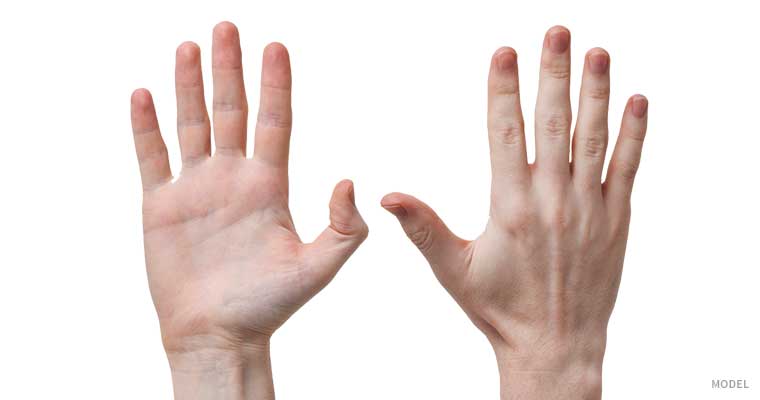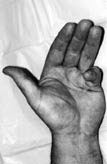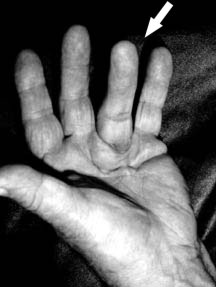
General Information
Many people find that as they age it becomes increasingly difficult to fully extend or stretch their fingers. In many cases, arthritis or some other joint disease may be to blame. But a condition in the palm of the hand may also cause the fingers to contract
Dupuytren’s (pronounced du-pwe-trahns’) contracture is a fairly common condition that occurs when the connective tissue (fascia) under the skin begins to thicken and shorten. As the tissue tightens, it may pull the fingers down towards the palm of the hand. In some individuals, the condition may progress until the involved fingers become disabled.

Who is at Risk?

- People of northern European descent. There is a genetic component to Dupuytren’s contracture.
- Men. The incidence of Dupuytren’s contracture is about seven times higher among men than among women.
- People of middle age. Most of the time, Dupuytren’s contracture doesn’t show up until after age 40. However, a very aggressive form may appear in teenagers and children.
- Diabetics.
- Alcoholics.
- People taking anticonvulsant drugs for epilepsy.
Signs & Symptoms
 The first sign is a thickening (nodule) in the palm of the hand that most frequently develops near the base of the ring or little finger. The nodule, which can resemble a callus, is painless but may be tender to the touch. Gradually, other nodules may develop and extend a contracture across the first joint into the finger. The overlying skin begins to pucker, and rough cords of tissue extend into the finger. As the process continues, these cords tighten and pull the finger in toward the palm. The ring finger is usually affected first, followed by the little, long and index fingers. The problem is not pain, but the restriction of motion and the deformity it causes.
The first sign is a thickening (nodule) in the palm of the hand that most frequently develops near the base of the ring or little finger. The nodule, which can resemble a callus, is painless but may be tender to the touch. Gradually, other nodules may develop and extend a contracture across the first joint into the finger. The overlying skin begins to pucker, and rough cords of tissue extend into the finger. As the process continues, these cords tighten and pull the finger in toward the palm. The ring finger is usually affected first, followed by the little, long and index fingers. The problem is not pain, but the restriction of motion and the deformity it causes.
The progress of the disease is often sporadic and unpredictable. Exactly what triggers the formation of nodules and cords is unknown. As the disease progresses, the diseased tissue wraps itself around and between normal tissue.
Many people do not seek medical care until the contracture is well advanced. The only treatment for this condition is surgery, which can be performed as an outpatient.
Surgical Treatment
Several different surgical techniques can be used to remove the thickened fascia and correct the contracture. Your surgeon will select a technique based on his or her experience, training, and approach. The aim of the surgery is to release the contracture and improve hand function by removing the diseased tissue.
